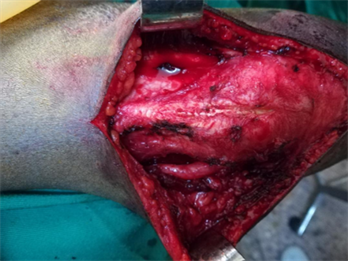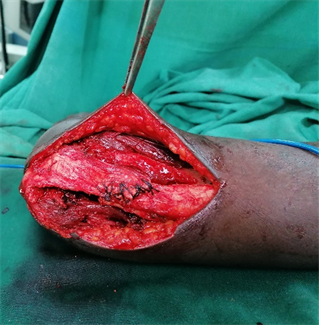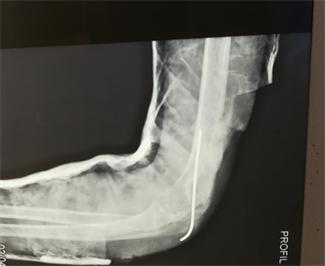Treatment of Neglected Elbow Dislocations by Z-Lengthening of the Triceps Brachii ()
1. Introduction
Elbow dislocations have an incidence of approximately 20% of all dislocations [1]. They are considered neglected or old when not treated or reduced within three weeks of injury [2] [3]. These lesions are a fairly common phenomenon in developing countries. The main reason for the delay in diagnosis is that patients initially seek treatment from traditional healers. These will immobilize the elbow in extension, which will lead to the retraction of the triceps muscle and collateral ligaments. The resulting stiffness of the elbow makes surgery quite difficult [4]. Thus, the treatment of neglected elbow dislocations is a challenge facing orthopedic surgeons in developing countries [5]. Various therapeutic methods are performed ranging from arthroplasty to arthrodesis through resection [6] [7] [8]. However, no therapeutic attitude is indicated to bring the best results. We performed several bloody reductions with Z lengthening of the triceps tendon. The authors evaluated their results and reviewed the literature with the aim of making their contribution to improving the technique and prognosis in the treatment of these lesions.
2. Patients and Method
We carried out a five-year prospective study (2013-2018) in the orthopedics- traumatology department of the Bouaké University Hospital. The study involved patients with unreduced elbow dislocation older than 21 days. All patients with a dislocated fracture and those whose x-ray showed joint fusion were not included in the study. We collected 26 patients, 20 men and 6 women with an average age of 27.5 years (17 and 45 years). The average consultation time was 8.9 months (3 - 13 months). The dominant side was affected in 17/26 cases. 20 patients were manual workers (driver, worker, farmer, shopkeeper, housewife), six were pupils/students. Table 1 summarizes the epidemiological and clinical characteristics of the patients. All dislocations were convergent postero-external (Picture 1). The mean elbow flexion preoperatively was 21.6˚ (5˚ - 40˚). The mean preoperative extension deficit was 7.1˚ (0˚ - 20˚). The mean range of motion was 14.8˚ (5˚ - 30˚) preoperatively. The mean prono-supination was 18.1 (10 - 30). The mean score of the Mayo Clinic elbow performance index [9] (Table 2) was 30 (20 - 35) preoperatively.
3. Protocol
The operations were performed under general anesthesia. The indication for surgical reduction was given for any dislocation older than three weeks. The patients were placed on an ordinary surgical table in lateral decubitus on the contralateral side; the injured arm was resting on a support; the forearm and hand dangling in the air, capable of being easily mobilized. The approach was posterior about 8 cm above the olecranon and 2 cm below the olecranon, the ulnar nerve was identified and isolated (Picture 2). The triceps tendon was cut in a Z-shape extending from its myotendin junction to the beak of the olecranon
F: female; M: masculine; P: patient; P/S: prono-supination; E1: preoperative extension; F1: preoperative flexion; A1: preoperative range of motion; E2: postoperative extension; F2: postoperative flexion; A2: postoperative range of motion; Min: minimum; Max: maximum; Avg: average; SA: sports accident; PHA: public highway accident.
![]()
Table 2. Mayo clinic elbow performance index.

Picture 1. Dislocation of the elbow.

Picture 2. Exposure of the triceps brachii tendon and ulnar nerve.
(Picture 3). The large sigmoid cavity and olecranon fossa were cleared of all fibrosis and fungus while avoiding damage to the cartilage. A pruning of the exostoses was carried out if they existed. The reduction was performed and stabilized by a 22/10 Kirchner wire in the olecranon humeral direction with the elbow flexed at 90˚ Lengthening of the triceps tendon by Z-plasty was performed (Picture 4 and Picture 5) [4]. A brachial-palmar plaster was made. Plaster and braces were removed after 3 weeks of immobilization followed by passive and then active rehabilitation (Picture 6). Patients were declared cured when physiotherapy could no longer improve range of motion. The patients were followed for a mean follow-up of 24 months. The elbow range of motion was measured before and after the operation. Patients were assessed with the Mayo Clinic Elbow Performance Index. X-rays were taken to assess the anatomical reduction. The stability of the elbow after surgery was assessed by questioning the patient and physical examination. The results were evaluated according to the clinical mayo score.
4. Results
The patients were reviewed after a mean follow-up of 24 months (14 - 36). We did not record any nerve damage. Two superficial surgical wound infections were treated with local dressings. Clinical examination did not note any instability in the patients. Analysis of standard x-rays showed that the dislocation was reduced in the 26 operated patients. The Mayo Clinic’s average elbow performance index was 77 (60 - 85), with 24 good and 2 average results. The mean extension deficit was 30.1˚ (10˚-55˚) (Picture 7). The mean flexion was 120.7˚ (105˚-160˚) (Picture 8 and Picture 9). The mean range of motion was 90.1˚ (65˚ - 130˚). The prono-supination was on average 69.1 (50 - 80). The average healing time was 4 months. The Nine Manual Workers resumed their rural activity without any embarrassment. The results are shown in Table 1. In total, all the patients resumed their former activity. We did not find a correlation between the duration of the lesion and functional recovery (p > 0.05). The Wilcoxon test showed that surgery significantly improved the overall range of motion of the elbow (p = 0.001).

Picture 3. Z incision of the triceps brachii tendon.

Picture 4. Lengthening of the triceps brachii tendon.

Picture 5. Anatomical reduction of the dislocation and stabilization by radio-humeral pin.

Picture 6. Patient in the physiotherapy room.

Picture 7. Elbow extension deficit.

Picture 8. Satisfactory elbow flexion.

Picture 9. Patient with his hand on the back of his neck.
5. Discussion
Our study has some weaknesses. The small sample size and the fact that it cannot be compared with the results of other surgical techniques. But it takes on an essential aspect because of its forward-looking nature. No patient was lost to follow-up. All patients were followed up regularly. Z-lengthening of the triceps in the treatment of neglected elbow dislocations is an innovative technique. it is commonly done for Achilles tendon injuries. About 90% of neglected elbow dislocations are posterolateral [10]. Treatment is quite difficult due to severe soft tissue contractures, ligament insufficiency and fibrosis, with possible associated nerve damage, ossifying myositis, patients not complying with the need for long-term physiotherapy. The goal of surgical treatment is to achieve a painless, stable and mobile elbow with congruent joint space. Neglected elbow dislocation also presents a significant socio-economic problem among the population. We had to take charge of a young population, mainly manual workers. This generates a significant socioeconomic impact. The observed delay in consultation is partly explained by a poor diagnosis made by traditional healers. They assimilate these lesions to fractures and will therefore immobilize the elbow in extension for several weeks believing to treat a fracture. Some exceptional complications such as incarceration of the median nerve have been reported [11]. This complication was not observed in our series. The two superficial infections recorded were controlled with antibiotic therapy and local dressings. several authors have long opted for non-surgical treatment because for them the functional benefit was limited [2] [12] [13]. Some authors believe that the result generally depends on the time it takes to develop the dislocation and the patient’s ability to tolerate the stiffness of the elbow. Most surgeons recommend a closed reduction for the dislocation of the elbow before 3 weeks after the elbow injury. After 3 weeks, soft tissue contractures and localized osteoporosis make closed reduction dangerous as manipulation can lead to fracture or damage to the joint surface [2] [3] [14]. However, surgery was not recommended for a long time [13] [15] [16]. But after several published series describing good results from open reduction, surgical treatment is now favored [2] - [8] [17] [18] [19] [20]. Some authors indicate that the outcome of surgery depends on how long the dislocation takes and how well the patient tolerates the associated stiffness of the elbow [1] [8] [13] [18]. Various therapeutic methods are therefore carried out, ranging from arthroplasty to arthrodesis via resection [6] [7] [8]. The patients we had to treat consulted late with an average delay of 7 months (3 - 12). These patients, however, were motivated by the surgery because they were convinced that they were doing better than their current condition. Especially after having long sought solutions from traditional healers. The posterior and lateral approaches are most often used in open reduction [3] [4] [7] [13] [16] [17]. The lateral approach has the advantage of providing good exposure to the humeral radial joint and anterior structures, in particular the coronoid fossa. However, the posteromedial capsule is not accessible and the ulnar nerve cannot be controlled. This approach is often paired with a medial approach, but it creates a second scar. As with many others, we prefer to use the posterior approach instead of the combined lateral and medial approach [2] [3] [4] [7] [8] [12] [13] [16] [17]. The posterior approach offers a good exposure of the structures which are generally retracted; Z-triceps plasty and ulnar nerve transposition is also easy, if necessary. The joint is reduced and fixed under visual control [7]. The overall aesthetic is also preferable, since there is only one surgical scar. Some authors [18] used an allograft of the Achilles tendon or fascia lata. This procedure requires further surgical preparation and could affect the healing and mechanical results of the elbow. Some authors recommend a blood reduction and the installation of an articulated external fixator without elongation of the tendon, which would facilitate rehabilitation and avoid possible instability. The lengthening that we achieved requires waiting for the tendon to heal before starting rehabilitation, but this technique gives satisfactory functional results (Table 1) with a clinical mayo performance index of 80 and an overall stable elbow. This Z-lengthening technique of the triceps tendon has the advantage of obtaining greater lengthening in front of significant retractions of the triceps, thus promoting good results despite the duration of the dislocation. The advantage of lengthening the triceps is to simplify the reduction procedure, especially in elbow dislocations with greater chronicity. The downside to lengthening is possible weakness of the triceps, delayed physiotherapy and increased postoperative pain.
6. Conclusion
Treatment of neglected elbow dislocations is difficult due to the accompanying retraction of the triceps. Among the many therapeutic methods, we believe that surgery remains an important option to restore the patient’s quality of life. The lengthening of the triceps is necessary to improve the functional results.
Authors’ Contribution
All authors contributed to the writing of this manuscript and gave their approval to the final version.